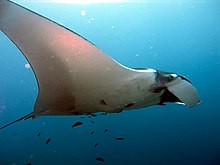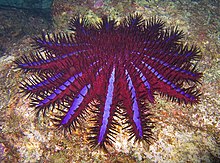Mu Ko Similan National Park
| Mu Ko Similan National Park | ||
|---|---|---|
|
|
||
| Location: | Phang Nga , Thailand | |
| Specialty: | National Marine Park | |
| Next city: | Thap Lamu | |
| Surface: | 140 km² | |
| Founding: | September 1, 1982 | |
| Visitors: | 149,449 (2007) | |
| Address: | www.dnp.org | |
| Map of the Pangnga Province with the area of the Mu Ko Similan National Park and the Similan Islands (excerpt) | ||
The National Park Mu Ko Similan ( Thai : หมู่ เกาะ สิ มิ ลัน ) is a National Park in the province of Phang Nga , southern Thailand . It is named after the archipelago of the nine Similan Islands in the Andaman Sea , which together with two other islands form the national park. The Marine National Park ( Thai : อุทยานแห่งชาติ หมู่ เกาะ สิ มิ ลัน ) was established on September 1, 1982 as the 43rd national park in Thailand.
history
Before the Royal Forestry Department established forest stations on Ko Miang and Ko Similan in the early 1980s , the archipelago was completely uninhabited. Only sometimes did Moken fish from boats in the fish-rich grounds. The Tourism Authority of Thailand promoted the Similans quickly. As a result, hundreds of years of coral growth were irretrievably destroyed in the first few years by dynamite fishing as well as by casting anchors and trawls, not only from tourist boats. Only the consistent enforcement of the parking rules that z. B. forbid fishing in the park area could prevent an ecological catastrophe. Allegedly, the presence of the park rangers alone is said to have contained the devastation - cutting trees for campfires, rubbish in and around the water. Growing environmental awareness among the local population as well as the tour operators has greatly improved the situation; the Similans are now considered a particularly good example of an Asia-Pacific reef system.
geography
The park covered an area of 128 km² (80,000 Thai rai ), of which 14 km² represents the area of the islands combined. In 1998, the park's border was moved around Ko Tachai Island . This is north of Ko Bon and the Similan group. The area of the park increased to 140 km². The headquarters of the national park administration with a visitor center is located in the port city of Thap Lamu .
Islands
Ko Tachai
The Tachai Island (also: Ko Ta-Chai, เกาะ ตา ชัย ) is located outside the actual Similan Islands and is the northernmost part of the national park of the same name. There is a white sandy beach on this island, but no accommodation. Diving is possible here and there are more frequent sightings of whale sharks , the largest fish in the world.
Ko Bon
The Bon ( เกาะ บอน ) or Talu Island ( เกาะ ทะลุ ) is located between the Similan Islands and Ko Tachai . The island consists only of rock and has no beach. Nevertheless, it is popular with divers because of the often encountered manta rays.
For the other nine islands see
Flora and fauna
flora
In the forests on the islands, the beach forest turns inland into tropical rainforest . Important species here are Manilkara spec. (see also Breiapfelbaum ), Cordia subcordata and Tournefortia argentea .
fauna
A large part of the seabed around the islands is covered by coral reefs , which are inhabited and formed by corals and sea anemones. The survival of the complex ecosystem is based on the symbiotic relationship with the alga zooxanthelle , which converts sunlight into nutrients. However, certain environmental factors such as temperature, salinity, light and wave activity must be right for this.
The hard corals most common in the reefs belong to the Acroporidae family . Another hard coral is the dainty Seriatopora hystrix from the Pocilloporidae family . There are also gorgonian fans, soft corals , lobsters , crabs , squids , sponges , sea cucumbers and giant clams in the sea . Among the vielzähligen coral reef fish include the butterfly fish , clown fish , angelfish , grunts and tilefish , even Gelblippen- sea snakes are found.
There are no large mammals living on the islands due to very little fresh water. 27 smaller mammals are counted, 16 of them bat species: the black- winged burial bat ( Taphozous melanopogon ), the Malay false vampire ( Megaderma spasma ), the long-winged bat Miniopterus australis and the naked bat Cheiromeles torquatus . There are three squirrel species , including the Gray-headed Flying Squirrel ( Hylopetes lepidus ) and four types of murinae : the yellow Rajah rat , the rice field rat ( Rattus argentiventer ) that Savile- Bandikutratte and the black rat ( Rattus rattus ). The long-tailed tassel spines ( Atherurus macrourus ) are rather rare , as well as the spotted musang and the Malay giant glider ( Cynocephalus variegatus ). Bottlenose dolphins live in the waters around the islands .
The holes of the Aldabra land crab ( Cardisoma carnifex ) are hard to miss . These very numerous crabs sometimes dig deep holes in which they disappear in the evening. The tension crab ( Ranina ranina ) can be found in abundance during their mating season, especially between September and December.
In 1992, according to a study, 22 reptile species and 39 bird species lived on the islands, including the Brahmin Weih ( Haliastur indus ), the Nicobar pigeon ( Caleonas nicobarica ) and the white-breasted water hen. The following migratory birds can be found on the Similan Islands from time to time: Pike cassin ( Gallinago stenura ), gray wagtail , barn swallow , cattle egret , faucet ( Gallicrex cinerea ) and the rose tern . The most common species are the reef freon , the collar pigeon and the two-colored fruit pigeon . The white-bellied sea eagle and the collared eagle can also be seen frequently .
Individual evidence
- ↑ Website of the National Park Administration ( Memento of the original from May 26, 2015 in the Internet Archive ) Info: The archive link was inserted automatically and has not yet been checked. Please check the original and archive link according to the instructions and then remove this notice. , accessed June 5, 2008
- ↑ Pharad̄et̄ Phayakwichiān, Pichai Sonjaeng: Regulations: controlling scuba diving for tourists. Surin Islands and Similan Islands National Parks . Tourism Authority of Thailand, Bangkok 2002, ISBN 974-679-059-2
- ↑ Similan Islands in: Monty Halls: Diving Worldwide , pp. 182-185
- ↑ Thai National Park Administration : Mu Ko Similan National Park ( Memento of the original from June 5, 2008 in the Internet Archive ) Info: The archive link was inserted automatically and has not yet been checked. Please check the original and archive link according to the instructions and then remove this notice. , accessed September 24, 2008
- ↑ Tassapon Krajangdara, Seiichi Watanabe Ti: Growth and reproduction of the red frog crab, Ranina Ranina (Linnaeus, 1758), in the Andaman Sea off Thailand . In: Fisheries Science . No. 71 , 2005, p. 20-28 , doi : 10.1111 / j.1444-2906.2005.00926.x .
literature
- JG Pattanayak: Marine sponges of Andaman and Nicobar Islands, India . In: Records of the Zoological Survey of India , Zoological Survey of India, Kolkata 2006, ISBN 81-8171-119-X
- DV Rao, Kamla Devi: A pictorial guide to butterfly and anemone fishes of Andaman & Nicobar islands . Zoological Survey of India, Kolkata 2004, ISBN 81-8171-027-4
- Dinlakā Sārikkabut: Khūmư̄ sat læ phư̄t nai nǣo pakārang mū ko̜ Surin læ Similan = Guide to coral reef fauna and flora of Surin and Similan islands . Bangkok 1998
- Denis Gray (inter alia): National Parks of Thailand . Communications Resources Ltd., Bangkok 1991, ISBN 974-88670-9-9
- Moo Ko Similan National Park . In: Sue Wells, Charles RC Sheppard, Martin Jenkins (Eds.): Coral Reefs of the World: Indian Ocean, Red Sea, and Gulf . United Nations Environment Program, IUCN Conservation Monitoring Center, International Union for Conservation of Nature and Natural Resources. 1988. ISBN 2-88032-944-2 , p. 380
Web links
- Mu Ko Similan National Park from the Thai Department of National Parks - description in English [last accessed on October 15, 2013]
- World Database on Protected Areas - Ao Phangnga - Mu Koh Surin - Mu Koh Similan (English)





